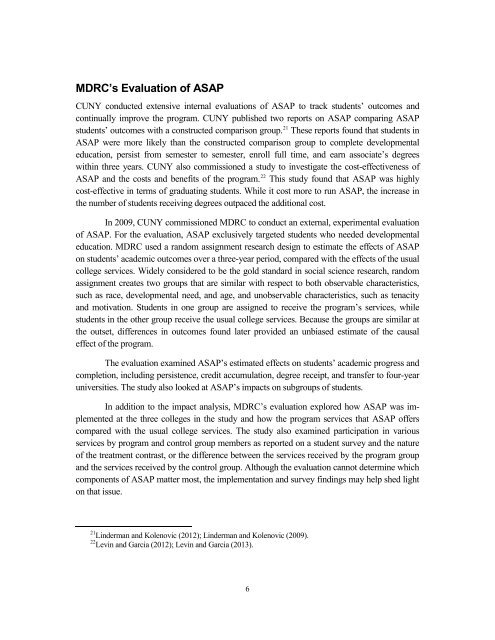1dOprzL
1dOprzL
1dOprzL
You also want an ePaper? Increase the reach of your titles
YUMPU automatically turns print PDFs into web optimized ePapers that Google loves.
MDRC’s Evaluation of ASAPCUNY conducted extensive internal evaluations of ASAP to track students’ outcomes andcontinually improve the program. CUNY published two reports on ASAP comparing ASAPstudents’ outcomes with a constructed comparison group. 21 These reports found that students inASAP were more likely than the constructed comparison group to complete developmentaleducation, persist from semester to semester, enroll full time, and earn associate’s degreeswithin three years. CUNY also commissioned a study to investigate the cost-effectiveness ofASAP and the costs and benefits of the program. 22 This study found that ASAP was highlycost-effective in terms of graduating students. While it cost more to run ASAP, the increase inthe number of students receiving degrees outpaced the additional cost.In 2009, CUNY commissioned MDRC to conduct an external, experimental evaluationof ASAP. For the evaluation, ASAP exclusively targeted students who needed developmentaleducation. MDRC used a random assignment research design to estimate the effects of ASAPon students’ academic outcomes over a three-year period, compared with the effects of the usualcollege services. Widely considered to be the gold standard in social science research, randomassignment creates two groups that are similar with respect to both observable characteristics,such as race, developmental need, and age, and unobservable characteristics, such as tenacityand motivation. Students in one group are assigned to receive the program’s services, whilestudents in the other group receive the usual college services. Because the groups are similar atthe outset, differences in outcomes found later provided an unbiased estimate of the causaleffect of the program.The evaluation examined ASAP’s estimated effects on students’ academic progress andcompletion, including persistence, credit accumulation, degree receipt, and transfer to four-yearuniversities. The study also looked at ASAP’s impacts on subgroups of students.In addition to the impact analysis, MDRC’s evaluation explored how ASAP was implementedat the three colleges in the study and how the program services that ASAP offerscompared with the usual college services. The study also examined participation in variousservices by program and control group members as reported on a student survey and the natureof the treatment contrast, or the difference between the services received by the program groupand the services received by the control group. Although the evaluation cannot determine whichcomponents of ASAP matter most, the implementation and survey findings may help shed lighton that issue.21 Linderman and Kolenovic (2012); Linderman and Kolenovic (2009).22 Levin and Garcia (2012); Levin and Garcia (2013).6


